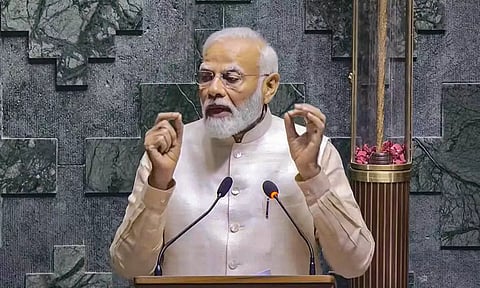

NEW DELHI: Anyone who believes that the Parliament represents the assembly of the people would have looked askance at the royalist symbolism that marked the inauguration of the new Parliament building by Prime Minister Narendra Modi on Sunday. The ceremony’s exclusive focus on one person, the PM, was at odds with the principle by which we cohere as a republic, which is that India’s sovereignty resides collectively with the people and no one individual.
Without the participation of the President, the embodiment of the people, the ceremony did not seem complete. It may also have been hastily planned. While the speaker of the Lok Sabha was present, the chairman of the Rajya Sabha was not. Inviting the latter, who is also the vice-president, but not the president, would perhaps have been odder still. Such twisted priorities indicate that the planners were stimulated by the need to showcase the magnificence of one person rather than the nobility of the occasion.
Indeed, it was the opposition parties’ decision to stay away from the function, but the Union government ought to have done more to build an atmosphere of consensus that would have brought together disparate forces and ideologies, which is central to the idea of India. It must count as a singular failure that there was no unity even over the consecration of Parliament. Despite differing over the expense of the project, India’s political parties ought to have united in this ceremony, as they did 75 years ago when we made our tryst with destiny. It’s appropriate to ask why there was such a unity in 1947, but not now. A plausible answer is that any semblance of such a unity has been rent by the divisive approach of this government in the past nine years. It ought definitely to be a concern for the people that such a deep disarray does not bode well for the republic.
There is also bound to be much criticism of the government over religious rituals holding centre stage in the inauguration. While the government did take care to organise an all-faith prayer as well, the liturgy on show did strike a discordant note in view of the secular basis of the republic. In his speech, the Prime Minister indicated that building a new Parliament was a response to the need to move away from our colonial legacy and to impart native cultural hues to India’s political processes. But was it necessary to incorporate the symbolism of the sengol on the basis of debatable and unrecorded history? As a political symbol, the sceptre smacks of monarchist tendencies that do not go well with a staunchly and irrevocably republican Constitution. For one thing, the whole ceremony on Sunday was centred around the handing over of the sengol by a battery of religious leaders, which made it look like a coronation rather than a reaffirmation of faith in democracy.
Even if we took the recent history of the sengol, as narrated by Home Minister Amit Shah, as the real truth, what exactly did it connote on Sunday? The sengol was ostensibly presented to the first Prime Minister Jawaharlal Nehru as a symbol of the transfer of power from Britain to India. Sunday’s ceremony was supposed to be about the consecration of a Parliament of the people. What transfer of power was involved? And from whom to whom?